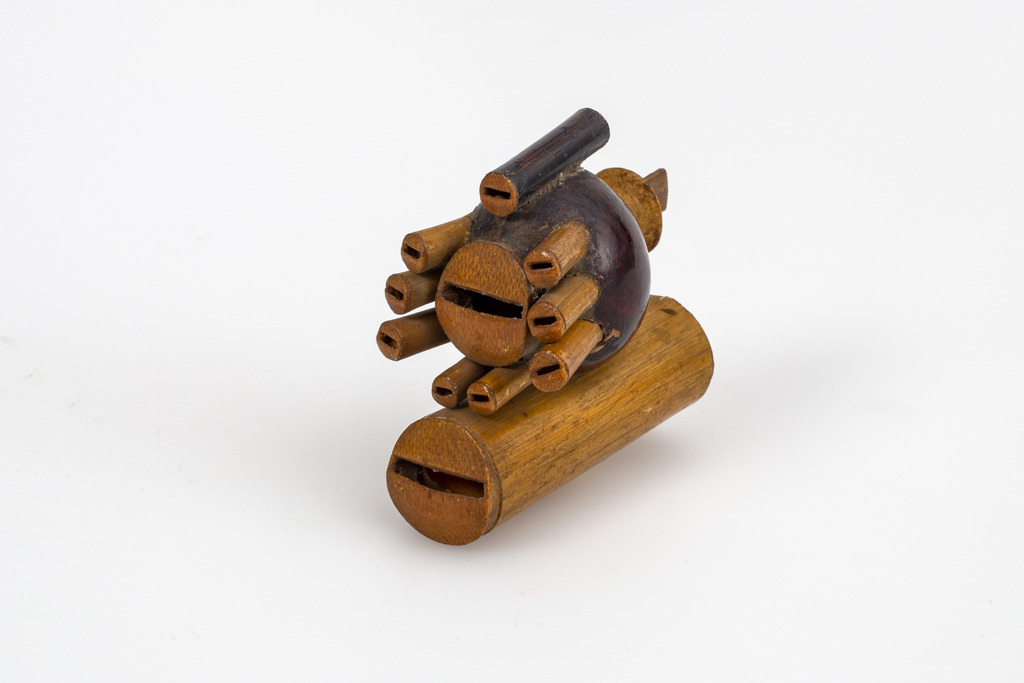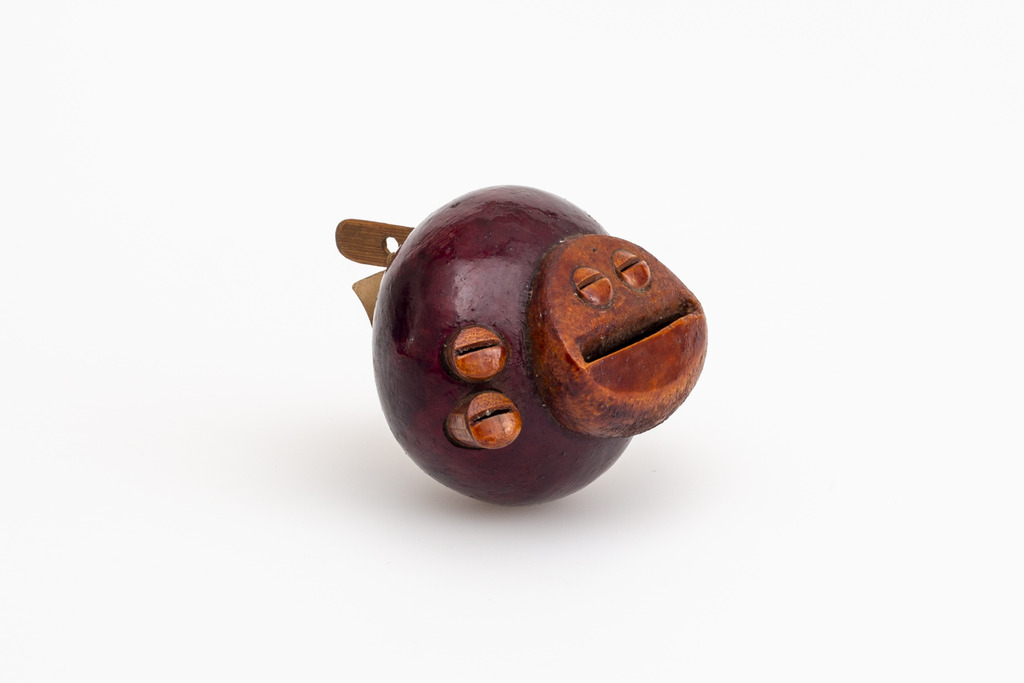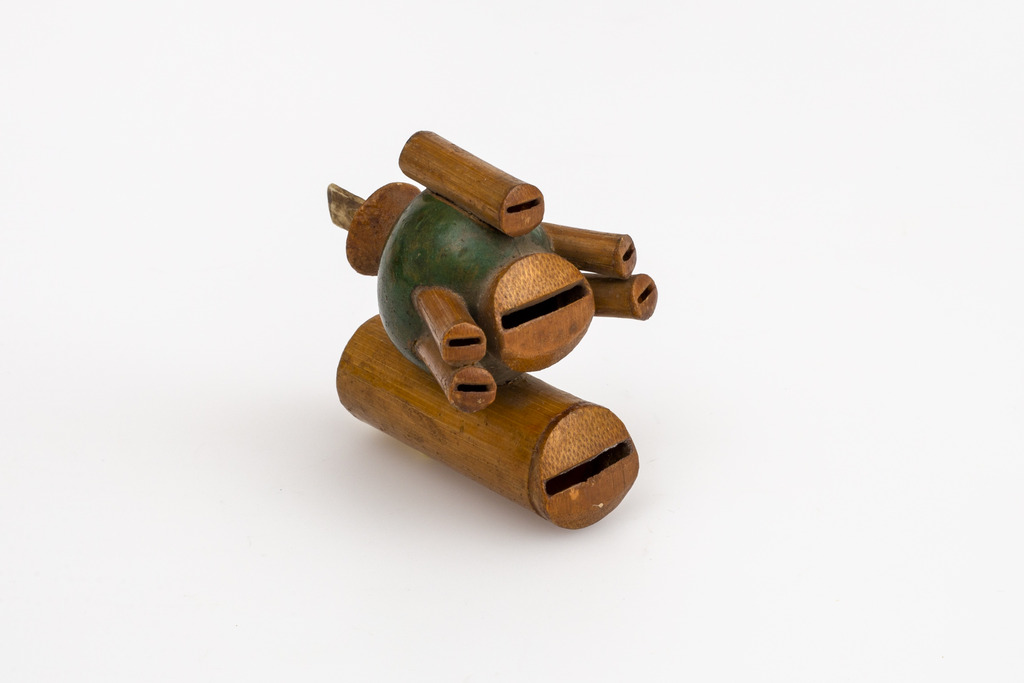by Dr. Klara Hrvatin, Department of Asian Studies, University of Ljubljana, Slovenia






Image copyright © Slovene Ethnographic Museum
Museum: The Slovene Ethnographic Museum (photo Blaž Verbič)
Inventory No.: Figure 1: 244 MG, Figure 2: 243 MG, Figure 3: 239 MG, Figure 4: 245 MG, Figure 5: 242 MG, Figure 6: 236 MG (Figures are labelled from left to right, from top to bottom.)
Name: Pigeon whistles
Author: Unknown
Place of Execution: China
Dating: 19th century
Material: gourd, bamboo, ivory
Dimensions (cm): height: 4-6; width: 4-5; length: 4-6 cm
The pigeon whistle, known in China as geling 鴿鈴 or geshao 鴿哨, is a small musical instrument belonging to the group of so-called Aeolian musical instruments. The whistle is attached to the tail of the pigeon so that it produces a sound when it flies. The flute is made of light materials such as gourd and bamboo and varnished. The makers enrich their image with engraved patterns and ivory ornaments. In China, the pigeon whistle has been used at least since the beginning of the Qing Dynasty (1644-1912), but it is also common in other Asian regions, such as Indonesia and Japan. In the past, the sound of the pigeon whistles, also known as “heavenly music”, presented a distinctive sound of Beijing.
The Slovene Ethnographic Museum holds a collection of 14 pigeon whistles. They are part of a larger collection of intendant Ivan Skušek Jr. (1877–1947), comprised of various objects such as paintings, statues, porcelain vessels, clothes, shoes, musical instruments, games, books, albums, photographs, coins, garden ceramics, furniture, and much more. As a special feature of the collection, Chinese instruments can be labelled as a rare and most extensive collection in Slovenia, including pigeon whistles.
The examples shown above present the three most common types of pigeon whistles found in the collection; the gourd type (Figure 3, 5, and 6), the tubular type (Figure 2) and the combined type (Figure 1 and 4). Among all these types, the gourd type is the most common representative – a type of pigeon whistle that has a carved gourd as its base to which bamboo sub-whistles are attached. The largest number of them is represented by small-sized pigeon whistles, with three sub-whistles and flower patterns in black on red or yellow (Figure 6).
Also more numerous are specimens of a combined type of pigeon whistles – the type with a gourd body in the middle, also called “star belly”, with a narrow tube attached to the front and a larger and wider tube attached to the back. In the photos you can see the representative of the “seven-star whistle” (Figure 4) and the “eleven-eye whistle” (Figure 1), which are similar in appearance. The former has a green lacquered gourd while the latter a dark red gourd; all other parts are unlacquered. In contrast to the abundance of gourd and combined type of pigeon whistles in the Skušek collection, there is only one example of the tubular type (Figure 2), which is characterised by clean lines, an overall construction of bamboo in natural colour, and a pure tone, with the shorter tube tuned higher than the longer tube.
Each type of pigeon whistle has its own distinctive sound. In a common arrangement, the gourd type of pigeon whistle would represent a bass tone, the tubular type would represent a soprano (a shorter pipe) and an alto (a longer pipe), while the combined type can produce tones of different pitch simply by virtue of its structure. The pigeon whistle is also distinguished by its special character – a carved Chinese character engraved on the back of the whistle. Although most of the pigeon whistles from the Skušek collection have engraved characters, they cannot be attributed to the major makers, i.e. the eight famous pigeon whistle makers.
Bibliography and useful links:
Hrvatin, Klara. Golobje piščali iz Skuškove zbirke Slovenskega etnografskega muzeja (Pigeon whistles from the Skušek collection of the Slovene Ethnographic Museum). Bulletin of the Slovene Ethnological Society 60, no. 1 (2020): 42-55.
Golobje piščali v Skuškovi zbirki (Pigeon Whistles in the Skušek Collection). VAZ; https://vazcollections.si/golobje-piscali-v-skuskovi-zbirki/, 22.1.2023.
Wang, Shixiang. Beijing Pigeon Whistles. Peking: Liaoning Education Press, 1999.
Wang, Shixiang. Tradition and Innovation: On Pigeon Whistles. In: Iftikhar Dadi (ur.), The Future is Handmade: The Survival and Innovation of Crafts. Prince Claus Fund Journal 10a (special issue), 2003, 14–30.
Hoose, Harned Pettus. Peking Pigeons and Pigeon-flutes. Peking: College of Chinese Studies, California College in China, 1938.
Laufer, Berthold. Chinese Pigeon Whistles. Scientific American 98/22, 1908, 394; https://www.jstor.org/ stable/10.2307/26018442, 4. 1. 2020.
China Today, The Pigeon Whistle: A Defining Sound of Old Beijing (documentary film), 27. 11. 2019; https://www.facebook.com/chinatoday1952/videos/2377966232444442, 23. 1. 2023.
The Beijing Pigeon Whistle – and Pigeon training tips / More China, 1.2.2018; https://www.youtube.com/watch?v=3i5xtadHPRA&ab_channel= =更中国MoreChina, 22.1.2023.
Trending China, Colin Siyuan Chinnery. Recording New and Old Sounds of Beijing, 2. 3. 2019; https://www.youtube.com/watch?v=V5EB73v1k9M&ab_channel=2MMediaGroup, 22. 1. 2023.
Muzej: Slovenski etnografski muzej (foto Blaž Verbič)
Inventarna št.: Slika 1: 244 MG, Slika 2: 243 MG, Slika 3: 239 MG, Slika 4: 245 MG, Slika 5: 242 MG, Slika 6: 236 MG (Slike so označene od leve proti desni, od zgoraj navzdol)
Ime: Golobje piščali
Avtor: Neznan
Kraj: Kitajska
Datacija: 19. stoletje
Material: buča, bambus, slonovina
Mere (v cm): višina: 4-6; širina: 4-5; dolžina: 4-6
Golobja piščal, na Kitajskem znana kot geling 鴿鈴 ali geshao 鴿哨, je majhno glasbilo, ki spada v skupino tako imenovanih eolskih glasbenih instrumentov. Piščalka je pritrjena na rep goloba, tako da oddaja zvok, ko golob leti. Izdelana je iz lahkih materialov, kot sta buča in bambus, ter lakirana. Izdelovalci njeno podobo večkrat obogatijo z graviranimi vzorci in okrasi iz slonovine. Na Kitajskem se golobja piščal uporablja vsaj od začetka dinastije Qing (1644–1912), vendar je pogosta tudi v drugih azijskih območjih, kot sta Indonezija in Japonska. V preteklosti je bil zvok golobjih piščali, znan tudi kot »nebeška glasba«, prepoznaven zvok Pekinga.
Slovenski etnografski muzej hrani zbirko 14 golobjih piščali. So del večje zbirke intendanta Ivana Skuška ml. (1877–1947), ki jo sestavljajo različni predmeti, kot so slike, kipi, porcelan, oblačila, glasbila, igre, knjige, albumi, fotografije, kovanci, vrtne keramične garniture, pohištvo itn. Kot posebnost zbirke lahko kot redko in najobsežnejšo zbirko na slovenskih tleh označimo tudi kitajska glasbila, vključno z golobjimi piščali.
Zgoraj prikazani primeri predstavljajo tri najpogostejše vrste golobjih piščali, ki jih najdemo v zbirki: bučni tip (Slike 3, 5 in 6), cevni tip (Slika 2) in kombinirani tip (Sliki 1 in 4). Najpogostejši predstavnik je bučni tip – vrsta golobje piščali, ki ima za osnovo izrezljano bučo, na katero so pritrjene bambusove pomožne piščali ali podpiščali. Najštevilčnejši so primerki bučnega tipa golobjih piščali manjšega formata s tremi podpiščalmi in cvetličnimi vzorci v črni barvi na rdeči ali rumeni podlagi (Slika 6).
Številčnejši so tudi primerki kombiniranega tipa golobjih piščali – tip z bučnim telesom v sredini, imenovan tudi zvezdni trebuh, z od spredaj pritrjeno ozko cevjo, zadaj pa z večjo in s širšo cevjo. Na fotografijah lahko vidimo predstavnika golobje piščalisedmih zvezd (Slika 4) in golobje piščalienajstih oči(Slika 1), ki sta si na videz podobna. Prvi ima zeleno lakirano bučo, drugi pa temno rdečo bučo; vsi ostali deli so nelakirani. V nasprotju s številčnostjo piščali bučnega in kombiniranega tipa je v Skuškovi zbirki le en primer cevnega tipa, t.i. dvocevni tip, ki ga odlikujejo čiste linije in celotna izdelava iz bambusa v naravni barvi.
Vsak tip golobje piščali ima svoj značilni zvok. Če si jih zamislimo v skupni postavitvi, bi predstavljal bučni tip golobjih piščali basovski ton, cevni tip sopranski (krajša cev) in altovski (daljša cev), kombinirani tip pa že sam po sebi vsebuje vse omenjene tone. Golobje piščali odlikuje tudi posebna oznaka – vgravirana kitajska pismenka na zadnji strani piščali. Čeprav so na večini golobjih piščali iz Skuškove zbirke vrezane oznake, ki bi lahko služile kot logotip izdelovalcev, pa teh ne moremo uvrstiti med osem glavnih izdelovalcev golobjih piščali.
Bibliografija
Hrvatin, Klara. Golobje piščali iz Skuškove zbirke Slovenskega etnografskega muzeja. Glasnik Slovenskega etnološkega društva 60, št. 1 (2020): 42-55.
Golobje piščali v Skuškovi zbirki. VAZ; https://vazcollections.si/golobje-piscali-v-skuskovi-zbirki/, 22.1.2023.
Wang, Shixiang. Beijing Pigeon Whistles. Peking: Liaoning Education Press, 1999.
Wang, Shixiang. Tradition and Innovation: On Pigeon Whistles. V: Iftikhar Dadi (ur.), The Future is Handmade: The Survival and Innovation of Crafts. Prince Claus Fund Journal 10a (special issue), 2003, 14–30.
Hoose, Harned Pettus. Peking Pigeons and Pigeon-flutes. Peking: College of Chinese Studies, California College in China, 1938.
Laufer, Berthold. Chinese Pigeon Whistles. Scientific American 98/22, 1908, 394; https://www.jstor.org/ stable/10.2307/26018442, 4. 1. 2020.
China Today, The Pigeon Whistle: A Defining Sound of Old Beijing (dokumentarni film), 27. 11. 2019; https://www.facebook.com/chinatoday1952/videos/2377966232444442, 23. 1. 2023.
The Beijing Pigeon Whistle – and Pigeon training tips / More China, 1.2.2018; https://www.youtube.com/watch?v=3i5xtadHPRA&ab_channel= =更中国MoreChina, 22.1.2023.
Trending China, Colin Siyuan Chinnery. Recording New and Old Sounds of Beijing, 2. 3. 2019; https://www.youtube.com/watch?v=V5EB73v1k9M&ab_channel=2MMediaGroup, 22. 1. 2023.